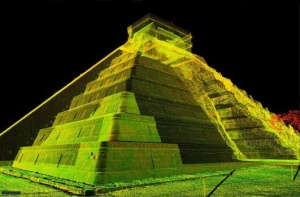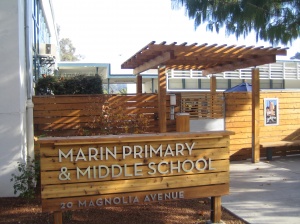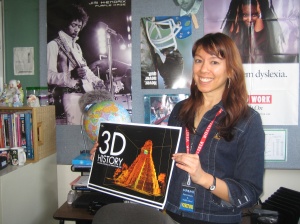CyArk Classroom Presentations at Marin Middle School: Maya Mathematics
Students use CyArk laser scan data to learn more about surface area at Tikal and Chichen Itza
December 12, 2008
On Friday, December 12, 2008 I had the opportunity to visit two classrooms at Marin Primary and Middle School. Arranged by the Yolanda Escandon, the school technology coordinator, I made two presentations about CyArk and the Maya at a seventh grade class and an eighth grade class.
The seventh grade presentation was held in Derek Berka and Jennifer Klem's classroom. During the presentation we examined Tikal and Chichen Itza's pyramids, looking at 3-D models and panoramas. The kids enjoyed the "virtual" field trip and commented that the VR panorama made them feel like they were really in the middle of the Great Plaza. We were also able to measure different parts of the pyramids and enjoy a bird's eye view of Temple 1 with the 3-D models.
So many of the kids had insightful comments and had a great knowledge of the Maya from their class. I had a lot of fun hearing all the questions that arose! Some of the most popular questions were about the ceremonies and sacrifices that took place at the Mayan sites. As a class we discussed the importances of sacrifice (yes, even human sacrifices!) as a way to appease the Mayan gods.
We also looked at reconstructions of Tikal, where Temple I were shown restored with intricate roofcombs and painted a brilliant red for a ceremony at the top of the pyramids. Looking at these images, I presented the kids with a challenge. "Which of the Mayan pyramids, Temple I at Tikal or El Castillo at Chichen Itza, required more red paint to cover the surface of the pyramids?"
As a classroom, we developed a strategy and formula for calculating the pyramids' surface area. This included the somewhat tricky tops of the pyramids. Derek and Jennifer were so helpful in assisting me with organizing the kids and helping explain the concepts during our math activity and I was so grateful for their help! Using CAD drawings of Temple I and El Castillo created from laser scan data, the kids were able to use the actual measurements of the pyramids to determine which pyramids had more surface area, and therefore needed more paint.
The eighth grade presentation was held at Sheila McBroom's classroom, where we talked about how CyArk uses computers in archaeology and looked at 3-D models of Mayan pyramids. The students had recently learned about Mesoamerican cultures in the fall semester and had lots of knowledge to offer. Many kids were interested in the science behind the laser scanner and VRs and asked how they were made. The fly-overs of various monuments at Chichen Itza got the kids really excited. During the class we all guessed how tall Temple I at Tikal was-and then measured the pyramids ourselves using CyArk's 3-D viewer. The pyramids were much taller than some of the kids had originally thought and they were very impressed with the Maya's building skills.
As a class we also discussed the many engineering and mathematical accomplishments of the Maya. The whole class was impressed by the 3-D models of the Chichen Itza's El Castillo and to learn about the astrological alignments and symbols on the pyramid. El Castillo has 4 staircases, each with 91 steps. If the temple is counted as 1 more step, the total number of steps in the pyramid equals 365-the same number of days calculated by the Maya to be in a year. Some of the kids shared stories with the class about the fascinating alignment of El Castillo. During the spring and autumn equinox of each year, a shadow on the staircase of El Castillo in the shape of a serpent glides down the staircase, a Mayan engineering feat to show the importance in these astronomical events.
I had a wonderful time with these two classrooms. The kids had such great insights and questions about the Maya and 3-D models that it really was a fun discussion! I was so grateful to all the teachers, Derek, Jennifer, Sheila and Yolanda, who took time out of their busy schedule to host me and help me teach their classes. I appreciated their efforts so much!
If you are in the San Francisco Bay Area and would like arrange for a free classroom visit from a CyArk representative, you can contact me, Nicole Medina, CyArk Education Program Developer at for more information.
for more information.
An online lesson plan of the Mayan surface area activity, including a description and student worksheets, will be posted soon on the CyArk Education pages. Check back soon for updates!
(For those of you who are curious, Chichen Itza's El Castillo has more surface area and would need more red paint than Tikal's Temple 1)
The seventh grade presentation was held in Derek Berka and Jennifer Klem's classroom. During the presentation we examined Tikal and Chichen Itza's pyramids, looking at 3-D models and panoramas. The kids enjoyed the "virtual" field trip and commented that the VR panorama made them feel like they were really in the middle of the Great Plaza. We were also able to measure different parts of the pyramids and enjoy a bird's eye view of Temple 1 with the 3-D models.
So many of the kids had insightful comments and had a great knowledge of the Maya from their class. I had a lot of fun hearing all the questions that arose! Some of the most popular questions were about the ceremonies and sacrifices that took place at the Mayan sites. As a class we discussed the importances of sacrifice (yes, even human sacrifices!) as a way to appease the Mayan gods.
We also looked at reconstructions of Tikal, where Temple I were shown restored with intricate roofcombs and painted a brilliant red for a ceremony at the top of the pyramids. Looking at these images, I presented the kids with a challenge. "Which of the Mayan pyramids, Temple I at Tikal or El Castillo at Chichen Itza, required more red paint to cover the surface of the pyramids?"
As a classroom, we developed a strategy and formula for calculating the pyramids' surface area. This included the somewhat tricky tops of the pyramids. Derek and Jennifer were so helpful in assisting me with organizing the kids and helping explain the concepts during our math activity and I was so grateful for their help! Using CAD drawings of Temple I and El Castillo created from laser scan data, the kids were able to use the actual measurements of the pyramids to determine which pyramids had more surface area, and therefore needed more paint.
The eighth grade presentation was held at Sheila McBroom's classroom, where we talked about how CyArk uses computers in archaeology and looked at 3-D models of Mayan pyramids. The students had recently learned about Mesoamerican cultures in the fall semester and had lots of knowledge to offer. Many kids were interested in the science behind the laser scanner and VRs and asked how they were made. The fly-overs of various monuments at Chichen Itza got the kids really excited. During the class we all guessed how tall Temple I at Tikal was-and then measured the pyramids ourselves using CyArk's 3-D viewer. The pyramids were much taller than some of the kids had originally thought and they were very impressed with the Maya's building skills.
As a class we also discussed the many engineering and mathematical accomplishments of the Maya. The whole class was impressed by the 3-D models of the Chichen Itza's El Castillo and to learn about the astrological alignments and symbols on the pyramid. El Castillo has 4 staircases, each with 91 steps. If the temple is counted as 1 more step, the total number of steps in the pyramid equals 365-the same number of days calculated by the Maya to be in a year. Some of the kids shared stories with the class about the fascinating alignment of El Castillo. During the spring and autumn equinox of each year, a shadow on the staircase of El Castillo in the shape of a serpent glides down the staircase, a Mayan engineering feat to show the importance in these astronomical events.
I had a wonderful time with these two classrooms. The kids had such great insights and questions about the Maya and 3-D models that it really was a fun discussion! I was so grateful to all the teachers, Derek, Jennifer, Sheila and Yolanda, who took time out of their busy schedule to host me and help me teach their classes. I appreciated their efforts so much!
If you are in the San Francisco Bay Area and would like arrange for a free classroom visit from a CyArk representative, you can contact me, Nicole Medina, CyArk Education Program Developer at
 for more information.
for more information.
An online lesson plan of the Mayan surface area activity, including a description and student worksheets, will be posted soon on the CyArk Education pages. Check back soon for updates!
(For those of you who are curious, Chichen Itza's El Castillo has more surface area and would need more red paint than Tikal's Temple 1)

<a href="/3d-scan-shot-of-el-castillo-media">3-D models</a> of El Castillo were used by 7th grade students to calcuate the surface area of a pyramid.

Marin Middle School was kind enough to invite me to their school to present about 3-D archaeology and the Maya.

I had a wonderful time with the students and teachers at Marin Middle school. A 3-D poster was given to each teacher.
- 48